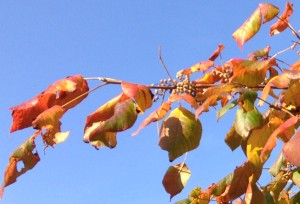Hello fellow readers, When I was a girl, my sister dared me to rub a leaf all over me. Even then, I was a plant person and always up to the ‘I dare you’ challenge. The leaf was in a grouping of three, and I picked one and dutifully painted myself with it. I bet you know where this is going.
It turns out I’m allergic to poison ivy, as are about 80 percent of us – some more than others. My reaction was awful (big surprise), causing my eyes to swell shut. Most people will indeed have a greater reaction with repeated or extreme exposure, such as dear Sis challenged me to do. Long forgiven, though my counter challenge to ride the red flyer wagon down the steep drive left permanent scars on her knees. :^0
Poison Ivy vs. Virginia Creeper
“What’s the bright red vine I have growing up my tree? Poison ivy?” asked Josephine of Andover, NJ. It could be, as poison ivy does turn a glorious bright red in fall. Virginia creeper, Parthenocissus quinquefolia, is often mistaken for poison ivy (Toxicodendron radicans) but has five leaflets – poison ivy has three. Come fall, Virginia creeper has dark purple berries while poison ivy has greyish-white ones.
Virginia creeper berries contain oxalic acid, which is moderately toxic to humans and other mammals but provides a food source for birds. The sap of the plant has needle-shaped crystals of calcium oxalate. If you crush the leaves, they can prick the skin, causing irritation and blisters to some, so wear gloves when handling.
The urushiol oil in all parts of the poison ivy plant (leaves, stems, roots, flowers, and berries) causes a reaction when touched by people. Yet poison ivy is commonly munched by many animals such as deer and bears, and birds enjoy the berries.
Both vines are known to cover trees or shrubs, killing them by shading their photosynthesizing ability. But before you wrestle them down, best to ID what you are tackling.
You may have heard rhymes to help identify poison ivy:
Leaflets three; let it be
Hairy vine, no friend of mine
and Berries white, run in fright.
Urushiol oil can remain active for years, so handling dead leaves or vines can still cause a bad reaction. And the oil can transfer to tools or pet fur than to you. Even if you think you aren’t allergic, a whopping exposure such as cutting up a downed tree wrapped in a dead poison ivy vine may cause a bad reaction. Isn’t that right, Curt? “If it’s hairy, you better ask Mary.”
Garden Dilemmas? AskMaryStone@gmail.com (and your favorite Podcast App.)
Warning: If you burn poison ivy and the smoke inhaled, a rash can appear on the lining of the lungs and cause extreme pain and possibly a fatal respiratory complication.
Tip: While Virginia creeper grows rampant in the wild, it’s also an ornamental plant. It can quickly cover walls keeping a building cooler by shading the surface, and its fall color is a show stopper. Though it adheres to the surface by disks rather than penetrating roots, it does not harm the masonry.
But, as with Boston ivy, ripping the plant from the wall can damage the surface. If you kill the plant first by cutting the vine at the root, the adhesive pads will eventually deteriorate and release their grip.
Link to tips on “Mary’s Technique” of Removing Poison Ivy
Column updated 11/6/21





